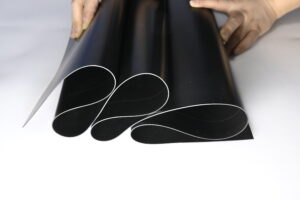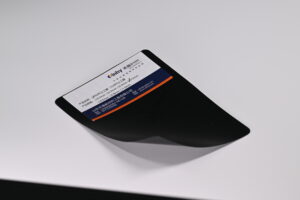geomembrane types
HDPE geomembrane is a waterproof and barrier material produced from (medium) high-density polyethylene resin. (Geomembrane with a density of 0.94g/cm3 or above).
The full name of HDPE geomembrane is “high density polyethylene film”. Service life (50 years).It is widely used in anti-seepage projects such as domestic waste landfills, solid waste landfills, sewage treatment plants, artificial lakes, and tailings treatment.
HDPE composite HDPE film is also known as high-density polyethylene film, HDPE geomembrane, HDPE anti-seepage film, HDPE film is a plastic coil composed of HDPE, and HDPE is a high crystallinity, non-polar thermoplastic resin. The appearance of the original HDPE is milky white, and the thin section is translucent to a certain extent. PE has excellent resistance to most domestic and industrial chemicals. Certain classes of chemicals can cause chemical corrosion, such as corrosive oxidizers (concentrated nitric acid), aromatic hydrocarbons (xylene) and halogenated hydrocarbons (carbon tetrachloride).

HDPE geomembrane Physical properties
① Excellent chemical resistance (corrosion resistance);
② Outstanding resistance to stress cracking (environmental stress cracking resistance);
③ The lowest permeability;
④ Excellent UV resistance;
⑤ Stable resistance to low temperature embrittlement;

HDPE geomembrane Features
1. HDPE geomembrane is a flexible waterproof material with a high anti-seepage coefficient (1×10-17 cm/s);
2. HDPE geomembrane has good heat resistance and cold resistance, and its operating environment temperature is high temperature 110 ℃, low temperature -70 ℃;
3. HDPE geomembrane has good chemical stability, can resist the corrosion of strong acid, alkali and oil, and is a good anti-corrosion material;
4. HDPE geomembrane has high tensile strength, so that it has high tensile strength and can meet the needs of high-standard engineering projects;
5. HDPE geomembrane has strong weather resistance, strong anti-aging performance, and can be used exposed for a long time while maintaining the original performance;
6. The overall performance of HDPE geomembrane, HDPE geomembrane has strong tensile strength and elongation at break, so that HDPE geomembrane can be used in various harsh geological and climatic conditions. Adapt to uneven geological settlement and strong strain!
7. HDPE geomembrane uses high-quality raw plastic and carbon black particles without any preservatives. HDPE has been used in my country to replace PVC as raw material for food packaging bags and fresh-keeping films.
HDPE geomembrane Construction method
Do not drag or drag the geomembrane during transportation to avoid being stabbed by sharp objects.
1. It should extend from the bottom to the high position, do not pull it too tightly, and leave a margin of 1.50% for partial sinking and stretching. Considering the actual situation of this project, the slope shall be paved from top to bottom;
2. The longitudinal joints of two adjacent panels should not be on a horizontal line, and should be staggered by more than 1m;
3. The longitudinal joint should be more than 1.50m away from the dam foot and the bend foot, and should be located on a plane;
4. First the side slope and then the bottom of the field;
5. When laying the side slope, the film spreading direction should be basically parallel to the maximum slope line.
HDPE geomembrane climate requirements
1. The temperature should generally be above five degrees Celsius. The geomembrane should be tense at low temperature and relaxed at high temperature.
2. The wind force is below level four.
3. When the temperature is too low, the construction should not be carried out in windy and rainy and snowy weather above level 4.
4. In windy weather, when the wind affects the construction of the geomembrane, the HDPE geomembrane to be welded should be pressed firmly with sand bags.


